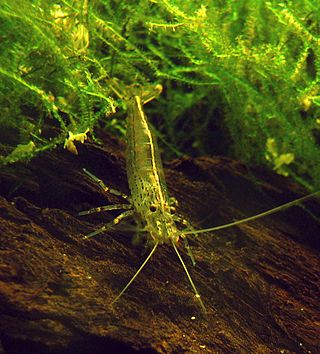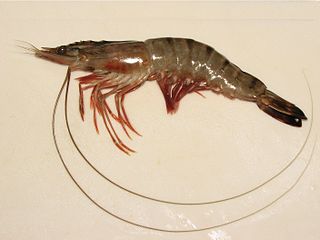
Slipper lobsters are a family (Scyllaridae) of about 90 species of achelate crustaceans, in the Decapoda clade Reptantia, found in all warm oceans and seas. They are not true lobsters, but are more closely related to spiny lobsters and furry lobsters. Slipper lobsters are instantly recognisable by their enlarged antennae, which project forward from the head as wide plates. All the species of slipper lobsters are edible, and some, such as the Moreton Bay bug and the Balmain bug are of commercial importance.

Cherax, commonly known as yabby/yabbies in Australia, is the most widespread genus of fully aquatic crayfish in the Southern Hemisphere. Various species of cherax may be found in both still and flowing bodies of freshwater across most of Australia and New Guinea. Together with Euastacus, it is also the largest crayfish genus in the Southern Hemisphere.

Atyidae is a family of shrimp, present in all tropical and most temperate waters of the world. Adults of this family are almost always confined to fresh water. This is the only family in the superfamily Atyoidea.

Lipke Bijdeley Holthuis was a Dutch carcinologist, considered one of the "undisputed greats" of carcinology, and "the greatest carcinologist of our time".

Penaeus monodon, commonly known as the giant tiger prawn, Asian tiger shrimp, black tiger shrimp, and other names, is a marine crustacean that is widely reared for food.

Palaemonidae is a family of shrimp in the order Decapoda. Many species are carnivores that eat small invertebrates, and can be found in any aquatic habitat except the deep sea. One significant genus is Macrobrachium, which contains commercially fished species. Others inhabit coral reefs, where they associate with certain invertebrates, such as sponges, cnidarians, mollusks, and echinoderms, as cleaner shrimps, parasites, or commensals. They generally feed on detritus, though some are carnivores and hunt tiny animals.

Palaemon is a genus of caridean shrimp in the family Palaemonidae.

Scyllarides latus, the Mediterranean slipper lobster, is a species of slipper lobster found in the Mediterranean Sea and in the eastern Atlantic Ocean. It is edible and highly regarded as food, but is now rare over much of its range due to overfishing. Adults may grow to 1 foot (30 cm) long, are camouflaged, and have no claws. They are nocturnal, emerging from caves and other shelters during the night to feed on molluscs. As well as being eaten by humans, S. latus is also preyed upon by a variety of bony fish. Its closest relative is S. herklotsii, which occurs off the Atlantic coast of West Africa; other species of Scyllarides occur in the western Atlantic Ocean and the Indo-Pacific. The larvae and young animals are largely unknown.

Scyllarides is a genus of slipper lobsters.
Arctides guineensis is a species of slipper lobster that lives in the Bermuda Triangle. It is known in Bermuda as the small Spanish lobster, a name which is also favoured by the FAO.

Macrobrachium is a genus of freshwater prawns or shrimps characterised by the extreme enlargement of the second pair of pereiopods, at least in the male.

Geryonidae is a family of crabs, including the following genera and species:

Prawn is a common name for small aquatic crustaceans with an exoskeleton and ten legs, some of which are edible.
Procaris hawaiana is a species of shrimp in the family Procarididae, from Maui, Hawaii. The species is very similar to Procaris ascensionis from Ascension Island. In P. ascensionis the integument is less firm, the rostrum is shorter, the cervical groove is more distinct, and the third abdominal somite reaches less far posteriorly over the fourth; also the scaphocerite has the final tooth still less distinct than in P. hawaiana, and the last segment of its antennal peduncle is less slender.
Calliasmata pholidota is a species of shrimp in the family Barbouriidae. It is thought C. pholidota is an opportunistic feeder, taking live prey or scavenging for food.

Palaemonella is a genus of shrimp in the family Palaemonidae, containing the following species:

Chaceon is a crab genus in the family Geryonidae, and was first described in 1989 by Raymond Manning and Lipke Holthuis.

Periclimenes, commonly known as glass shrimp or cleaner shrimp, is a commensal and often symbiotic genus of semi-transparent shrimp within the family Palaemonidae. Species of this large genus feature a wide variety of coloration and patterns, widespread distribution throughout much of the world's tropical oceans, and are often sought out for aquarium trade.
Cryphiops is a genus of shrimp belonging to the family Palaemonidae.











